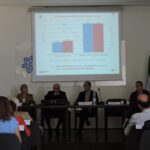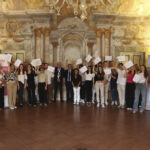Mass in the Palazzo Sansedoni Chapel Thursday 20 March
To commemorate the anniversary of the death of Blessed Ambrogio Sansedoni, a Sienese theologian and a classmate and admirer of Saint Thomas Aquinas, on Thursday 20 March the Monte dei Paschi di Siena Foundation will have the traditional Masses said in the chapel inside the foundation’s headquarters at 34 Banchi di Sotto.
At 9:00 a.m., Mass will be celebrated by the Archbishop of Siena, Antonio Buoncristiani, in the presence of local authorities. The 10:00 a.m. Mass will be officiated by the Dominican Father Alfredo Scarciglia, and 11:00 a.m. Mass will be said by the parish priest of the church of Beato Ambrogio Sansedoni, Father Tito Rovai.
On this occasion, as is traditional, gifts of money will be made to the needy of Siena and the blessed bread will be distributed.
Blessed Ambrogio Sansedoni
Ambrogio Sansedoni (Siena, 16 April 1220 – 20 March 1286), the best-known member of the noble family which owned the palace that is now the seat of the MPS Foundation, entered the Dominican order at the age of 17. During his studies in Cologne, he was taught by Saint Albert the Great and had as classmates Saint Thomas Aquinas and Pietro di Tarantasia, the future Pope Innocent V.
Called to Paris to teach, Ambrogio made a name for himself mainly through the power of his preaching, both in church and in the public squares. Some painters have depicted him with the Holy spirit, in the form of a dove, speaking into his ear.
He had exceptional gifts of persuasion; it is due to him that a schism did not erupt in Germany in 1245 over the dissension between the Council of Lyon and Emperor Frederick II. When Frederick died, his son Manfred attempted to recover the imperial territories in southern Italy. Siena took his side, and as a consequence Pope Clement issued an interdict against the city (meaning that it was forbidden to celebrate the sacraments there). Ambrogio Sansedoni therefore rushed to speak with the pope, who was in Orvieto at the time, in defense of his fellow townspeople. His plea was so vigorous that it convinced the pope. His oratory ability was admired in Paris, Germany and the many Italian cities where he was a leader in seeking to defuse conflicts, put together truces, and stop the fighting. He was a persuasive and untiring reconciler, using words that were clear and impassioned at the same time. Despite his talents, however, he was not able to save Conradin of Swabia, the last German prince fighting for control of southern Italy after the defeat and death of Manfred. Beaten at Tagliacozzo in 1268, Conradin was turned over to Charles of Anjou, who sentenced him to death despite the efforts of Ambrogio (in Naples at the time), who had even the pope intervene. After numerous travels, Ambrogio returned to Siena, resuming his preaching. And there he died, struck down by an attack during one of his celebrated orations.
Siena later commemorated him by placing his bust on the cathedral façade and dedicating a Palio to him, run until the middle of the sixteenth century. In 1597 Pope Clement VIII placed his name on the Roman Martyrology.
On the occasion of the seventh centenary of his death, Blessed Ambrogio was featured on the banner for the Palio of 2 July 1986, painted by Carlo Cerasoli, a comic draftsman and painter, which was won by the Drago contrada. The iconography for the banner was taken from the fresco by Sano di Pietro in the Sala delle Lupe in the Palazzo Pubblico.






